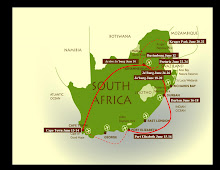Sunday night was spent writing and learning more about South Africa. Since it’s pretty easy for South Africans to spot an American abroad, I chose to exploit being a Westerner. I asked the staff at the Backpack and Travel Center a handful of probing questions about Cape Town, South Africa and perceptions of both.
South Africa is a beautiful combination of cosmopolitan cities like here and Johannesburg as well as the rural bush too many people think is prevalent here. Before I left I knew the Big Five did not roam the streets of any city, but my conversation with Melanie, Caroline and Brandon in Cape Town ensured any lingering perceptions akin to that were complete rubbish.
Unfortunately it was during my conversation with Brandon that my hopes of going to Robben Island were dashed. He told me that when it rains in Cape Town the Atlantic Ocean swells to as high as 30 feet—making it impossible and unsafe for a ferry to carry people 10 kilometers into the sea.
I called my girlfriend to see if we could organize a return trip to the Western Cape during my final two days in South Africa. We looked up flights, accommodations, whether there was a game here and the availability of everything before I resigned myself to the fact I was not going to Robben Island—on this trip.
Monday, I slept in. In search of a museum or something colorful I was told about a sightseeing bus that would take me through Cape Town and the surrounding beaches for R120.
This bus took people up Table Mountain for the pictures of a lifetime. Then through the suburban beaches that are popular with photographers—of the personal and professional variety. Finally my two-hour tour concluded with a jaunt through the heart of the city.
Driving by the white building that created, then dismantled apartheid was surreal. To add to the mix of emotions was driving past the District 6 neighborhood, which is less than a quarter mile from the origin of South African bigotry.
District 6 was a predominately black neighborhood that was razed in the 60s because the government wanted to redevelop this part of Cape Town. Our guide told us 85 percent of District 6 remains uninhabited. More than 40 years later there are still patches of land that are little more than grass and weeds—quiet symbols of the once vibrant community that had homesteads here.
(I couldn’t help but think of New Orleans and the Lower Ninth Ward as I snapped pictures of District 6. It wasn’t until days later that my mind allowed me to realize that District 6 was completely a man-made wasteland.)
I took the sightseeing tour twice, once to see the city and a second time to avoid having to pay a taxi to take me from my hostel to the bus station. With the Italy-Paraguay game kicking off later Monday evening traffic downtown was as thick as a stereotypical Italian defense.
Eventually, I caught my bus for the 12-hour trip up to Port Elizabeth. My 36 hours in Cape Town were over. My adventures battling the rain, wind and cold were just beginning.
Wednesday, June 16, 2010
Cape of Storms lives up to billing. (36 Hours in Cape Town part II)
Subscribe to:
Post Comments (Atom)



Crazy how u described District 6 the same way Peter Jackson designed the movie District 9...
ReplyDelete